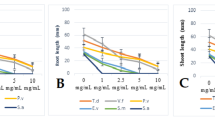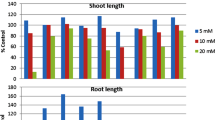Abstract
The biological activity of aqueous extracts of velvetleaf (Abutilon theophrasti Medik.) seed coats and their flavonoid components against three plant species and five soil fungi was investigated. Aqueous extracts slightly inhibited germination and significantly inhibited radicle growth of all plant species tested. Fungal growth was inhibited or not affected, depending on species, by aqueous extracts. The aqueous extracts were extracted into methanol and separated using paper chromatography for identification of compounds responsible for inhibition of seedling and fungal growth. Six flavonoid compounds were isolated and tentatively identified as delphinidin, cyanidin, quercetin, myricetin, (+)-catechin, and (−)-epicatechin. Bioassays revealed that the flavonoid compounds significantly inhibited germination and radicle growth of all test species at a concentration of 1.0 mM. Individual flavonoids had variable effects on fungi but appeared to inhibit growth and sporulation of potential seed-decomposing fungi rather than “beneficial” fungi. These results indicate that the flavonoid complement of velvetleaf seed coats may function in a dual defensive role against competing seedlings and seed-attacking fungi.
Similar content being viewed by others
References
Bate-Smith, E.C., andRibereau-Gayon, P. 1958. Leuco-anthocyanins in seeds.Qual. Plant. Mater. Veg. 5:189–198.
Broadhurst, R.B., andJones, W.T. 1978. Analysis of condensed tannins using acidified vanillin.J. Sci. Food Agric. 29:788–794.
Byrde, R.J.W. 1963. Natural inhibitors of fungal enzymes and toxins in disease resistance, pp. 31–47,in S. Rich (ed.). Perspectives in Biochemical Plant Pathology. Connecticut Agricultural Experiment Station Bulletin No. 663.
Egley, G.H., andChandler, J.M. 1983. Longevity of weed seeds after 5.5 years in the Stoneville 50-year buried-seed study.Weed Sci. 31:264–270.
Elmore, C.D. 1980. Inhibition of turnip (Brassica rapa) seed germination by velvetleaf (Abutilon theophrasti) seed.Weed Sci. 28:658–660.
Feenstra, W.J. 1960. The genetic control of the formation of phenolic compounds in the seedcoat ofPhaseolus vulgaris L., pp. 127–131,in J.B. Pridham (ed.). Phenolics in Plants in Health and Disease. Pergamon Press, Oxford, U.K.
Flood, A.E., andKirkham, D.S. 1960. The effect of some phenolic compounds on the growth of twoVenturia species, pp. 81–85,in J.B. Pridham (ed.). Phenolics in Plants in Health and Disease. Pergamon Press, Oxford, U.K.
Friedman, J., andWaller, G.R. 1983. Seeds as allelopathic agents.J. Chem. Ecol. 9:1107–1117.
Gressel, J.B., andHolm, L.B. 1964. Chemical inhibition of crop germination by weed seeds and the nature of inhibition byAbutilon theophrasti.Weed Res. 4:44–53.
Halloin, J.M. 1982. Localization and changes in catechin and tannins during development and ripening of cottonseed.New Pytol. 90:651–657.
Halloin, J.M. 1983. Deterioration resistance mechanisms in seeds.Phytopathology 73:335–339.
Harborne, J.B. 1984. Pages 37–99,in Phytochemical Methods. Phenolic Compounds. Chapman and Hall, London.
Horowitz, W. 1980. Page 158,in Official Methods of Analysis of the Association of Official Analytical Chemists. Tannin. A.O.A.C., Washington, D.C.
Kraft, J.M. 1977. The role of delphinidin and sugars in the resistance of pea seedlings toFusarium root rot.Phytopathology 67:1057–1061.
Kremer, R.J. 1986. Antimicrobial activity of velvetleaf (Abutilon theophrasti) seeds.Weed Sci. 34:617–622.
Kremer, R.J., Hughes, L.B., andAldrich, R.J. 1984. Examination of microorganisms and deterioration resistance mechanisms associated with velvetleaf seed.Agron. J. 76:745–749.
LaCroix, L.J., andStaniforth, D.W. 1964. Seed dormancy in velvetleaf.Weeds 12:171–174.
Lueschen, W.E., andAndersen, R.N. 1980. Longevity of velvetleaf (Abutilon theophrasti) seeds in soil under agricultural practices.Weed Sci. 28:341–346.
Markham, K.R. 1982. Techniques of Flavonoid Identification. Academic Press, London.
Panasiuk, O., Bills, D.D., andLeather, G.R. 1986. Allelopathic influence ofSorghum bicolor on weeds during germination and early development of seedlings.J. Chem. Ecol. 12:1533–1543.
Picman, A.K., Giaccone, R., Ivarson, K.C., andAltosar, I. 1984. Antifungal properties of oat hulls.Phytoprotection 65:9–15.
Popovici, G., andReznik, H. 1976. The effect of some flavonoids on the protoplasmic streaming in oat (Avena sativa) root hairs.Z. Pflanzenphysiol. 80:417–425.
Rai, J.P.N., andTripathi, R.S. 1984. Allelopathic effects ofEupatorium ripariam on population regulation of two species ofGalinsoga and soil microbes.Plant Soil 80:105–117.
Rasmussen, J.A., andEinhellig, F.A. 1977. Synergistic inhibitory effects ofp-coumaric and ferulic acids on germination and growth of grain sorghum.J. Chem. Ecol. 3:197–205.
Retig, B., Holm, L.G., andStuckmeyer, B.E. 1972. Effects of weeds on the anatomy of roots of cabbage and tomato.Weed Sci. 20:33–36.
Robinson, T. 1980. Pages 191–225,in The Organic Constituents of Higher Plants. Flavonoids and Related Compounds. Cordus Press, North Amherst, Massachusetts.
Rubia, T. de la, Gonzalez-Lopez, J., Martinez-Toledo, V., Moreno, J., andRamos-Cormenzana, A. 1987. Flavonoids and the biological activity ofAzotobacter vinelandii.Soil Biol. Kochem. 19:223–224.
Spencer, N.R. 1984. Velvetleaf,Abutilon theophrasti (Malvaceae), history and economic impact in the United States.Econ. Bot. 38:407–416.
Weston, L.A., Burke, B.A., andPutnam, A.R. 1987. Isolation, characterization and activity of phytotoxic compounds from quackgrass[Agropyron repens (L.) Beauv.].J. Chem. Ecol. 13:403–421.
Williams, R.D., andHoagland, R.E. 1982. The effects of naturally occurring phenolic compounds on seed germination.Weed Sci. 30:206–212.
Young, H., andPaterson, V.J. 1980. Condensed tannins from white clover seed diffusate.Phytochemistry 19:159–160.
Author information
Authors and Affiliations
Additional information
Journal article No. 9878 of the Missouri Agricultural Experiment Station.
Rights and permissions
About this article
Cite this article
Paszkowski, W.L., Kremer, R.J. Biological activity and tentative identification of flavonoid components in velvetleaf (Abutilon theophrasti Medik.) seed coats. J Chem Ecol 14, 1573–1582 (1988). https://doi.org/10.1007/BF01012523
Received:
Accepted:
Issue Date:
DOI: https://doi.org/10.1007/BF01012523




